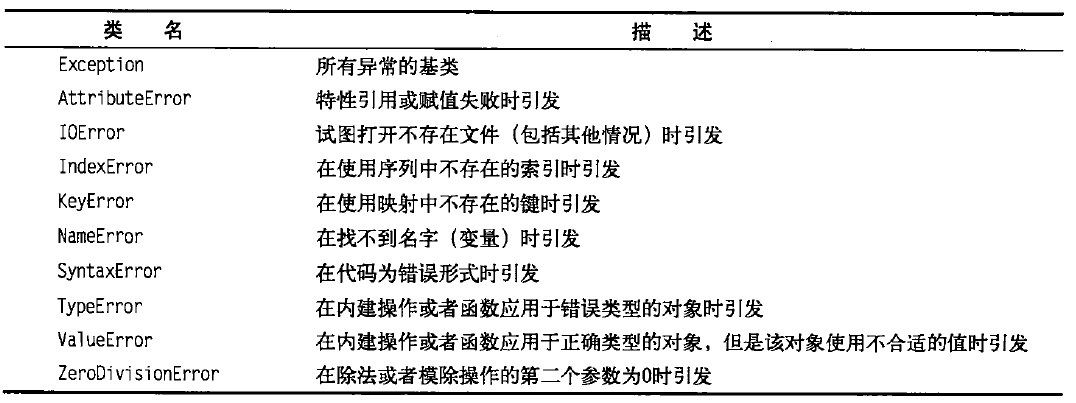一、按照自己的方式出错
1、raise语句
raise语句可以引发异常:
>>> raise Exception
Traceback (most recent call last):
File "<pyshell#0>", line 1, in <module>
raise Exception
Exception
>>> raise Exception('hyperdrive overload')
Traceback (most recent call last):
File "<pyshell#1>", line 1, in <module>
raise Exception('hyperdrive overload')
Exception: hyperdrive overload>>> import exceptions
>>> dir(exceptions)
['ArithmeticError', 'AssertionError', 'AttributeError', 'BaseException', 'BufferError', 'BytesWarning', 'DeprecationWarning', 'EOFError', 'EnvironmentError', 'Exception', 'FloatingPointError', 'FutureWarning', 'GeneratorExit', 'IOError', 'ImportError', 'ImportWarning', 'IndentationError', 'IndexError', 'KeyError', 'KeyboardInterrupt', 'LookupError', 'MemoryError', 'NameError', 'NotImplementedError', 'OSError', 'OverflowError', 'PendingDeprecationWarning', 'ReferenceError', 'RuntimeError', 'RuntimeWarning', 'StandardError', 'StopIteration', 'SyntaxError', 'SyntaxWarning', 'SystemError', 'SystemExit', 'TabError', 'TypeError', 'UnboundLocalError', 'UnicodeDecodeError', 'UnicodeEncodeError', 'UnicodeError', 'UnicodeTranslateError', 'UnicodeWarning', 'UserWarning', 'ValueError', 'Warning', 'WindowsError', 'ZeroDivisionError', '__doc__', '__name__', '__package__']2、自定义异常类
自定义异常类只需要继承Exception类
>>> class SomeCustomException(Exception):pass捕捉异常使用try/except
try:
x=input('Enter the first number: ')
y=input('Enter the second number: ')
print x/y
except ZeroDivisionError:
print "The second number can't be zero!"
try:
x=input('Enter the first number: ')
y=input('Enter the second number: ')
print x/y
except ZeroDivisionError:
print "The second number can't be zero!"
except TypeError:
print "That wasn't a number.was it?"如果需要用一个块捕捉多个异常,那么可以将它们作为元祖列出:
try:
x=input('Enter the first number: ')
y=input('Enter the second number: ')
print x/y
except (ZeroDivisionError,TypeError,NameError):
print "Your number were bogus..."
如果希望在except子句中访问异常对象本身,可以使用两个参数(注意,如果是捕捉到多个异常,需要向except子句提供一个参数——元祖。第二个参数e):
try:
x=input('Enter the first number: ')
y=input('Enter the second number: ')
print x/y
except (ZeroDivisionError,TypeError,),e:
print e
如果想捕捉所有异常,可以在except子句中忽略所有的异常类:
try:
x=input('Enter the first number: ')
y=input('Enter the second number: ')
print x/y
except:
print 'Something wrong happend...'
七、try/except加上else子句
try:
print 'A simple task'
except:
print 'What? Something went wrong?'
else:
print 'Ah....It went as planned.'A simple task
Ah....It went as planned.x=None
try:
x=1/0
finally:
print 'Cleaning up....'
del x还可以和else一起使用:
try:
1/0
except NameError:
print "Unknown variable"
else:
print "That went well!"
finally:
print "Cleaning up"
如果异常在函数内引发而不处理,它就会传播至函数调用的地方。如果依旧没有被处理,就会继续传播,直到主程序。如果还没有被处理,程序会带着栈跟踪中止。
>>> def faulty():
raise Exception('Something is wrong')
>>> def ignore_exception():
faulty()
>>> def handle_exception():
try:
faulty()
except:
print 'Exception handled'
>>> ignore_exception()
Traceback (most recent call last):
File "<pyshell#12>", line 1, in <module>
ignore_exception()
File "<pyshell#5>", line 2, in ignore_exception
faulty()
File "<pyshell#2>", line 2, in faulty
raise Exception('Something is wrong')
Exception: Something is wrong
>>> handle_exception()
Exception handled
























 4723
4723

 被折叠的 条评论
为什么被折叠?
被折叠的 条评论
为什么被折叠?








